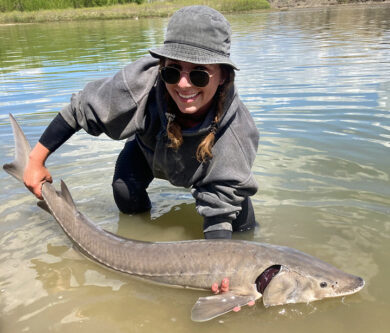Aquaculture centre fishing for virus in Alberta sturgeon
By Herald on August 17, 2021.
 Fourth year Ecosystem Management student Abigail Doerksen shows off a large sturgeon catch. Lethbridge College photo
Fourth year Ecosystem Management student Abigail Doerksen shows off a large sturgeon catch. Lethbridge College photoTim Kalinowski – Lethbridge Herald
Lethbridge College researchers are on the hunt for the herpes virus in Oldman and South Saskatchewan River wild sturgeon populations. And if they find it, it could lead to a revolutionary changeover in the way the college conducts aquaponics research.
“We are trying to see if the sturgeon herpes virus is here in Alberta in the South Saskatchewan, Oldman River system,” confirms John Derksen, chair of the Aquaculture Centre for Excellence at Lethbridge College. “What the prevalence of it is. And if it is here, that opens the door for us to bring sturgeon into to actually raise them.”
Aquaponics is the science of using fish excretions to fertilize and grow plants in.
Derksen says the college eventually hopes to replace their current tilapia populations they use for aquaponics research because the breed comes with notable problems for operations. They grow up too fast, he says, and have to be marketed and sold every nine months to preserve their meat value. And while they try to batch source all males some females do inevitably sneak through which leads to baby fish being born and getting into pipes, valves and lines and plugging them up. The beneficial thing about sturgeon is they have a long lifespan and don’t sexually mature for 15 or 20 years. This slow growth factor, combined with overfishing and environmental decline, has led to their population decrease in the wild, but would be perfect for the college’s aquaponics program. The fish when they mature could either then be harvested for meat or caviar production after that time, says Derksen.
But, says Derksen, there is one notable problem in bringing them in.
“Long story short; we tried to get sturgeon, but a lot of the sturgeon commercial operations have this sturgeon herpes virus,” he explains, bringing the story around full circle. “So the provincial government said, ‘You are not bringing those sturgeon in because they have this virus.’ We were under the assumption this virus was throughout Canada- it’s endemic. And the provincial government said, ‘No, you have got to prove it is here. Because we have no evidence it is in Alberta.’’
So Derksen had to hire four students to fish for the summer to collect evidence of endemic herpes in local sturgeon populations before they could move to the next stage of their commercially raised sturgeon operation at the college.
Derksen admits his students were pretty “thrilled” to be paid to fish for the entire summer, but he also expected big results. He was granted permits to catch 180 fish who would have small tissue samples taken from their fins for testing before being released.
It didn’t quite go according to plan, he says.
“We are trying to get as many samples as we can, but it has been an absolutely awful year to get them,” Derksen confirms. “Water levels did not come up very high, and that is what typically drives them to congregate and spawn. It just didn’t happen. So we have a permit for collecting 180 samples, but I think at last I counted we are at about 56.”
Derksen still thinks his team might have collected enough samples to prove the herpes’ case, but he is still awaiting the return of lab results. If his team can prove there is no danger to local wild sturgeon populations from commercially-raised fish because they share the same virus, Derksen is hoping to be upgrading the current fish tanks used for the much smaller tilapia and getting into sturgeon-fueled aquaponics production by the end of next year.
Follow @TimKalHerald on Twitter
14-13


